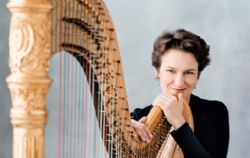|
Symphony
SRS SEASON ENDS WITH RESOUNDING TA-TA-TA-BANG
by Terry McNeill
Sunday, June 1, 2025
Symphony
YOUTHFUL VIRTUOSITY ON DISPLAY AT USO'S MAY CONCERTS
by Peter Lert
Saturday, May 17, 2025
Symphony
MYSTICAL PLANETS AND LIVELY GERSHWIN ORTIZ AT FINAL SRS CONCERT
by Peter Lert
Sunday, May 4, 2025
Symphony
VSO'S CONCERT MUSIC OF TIME, MUSIC OF PLACE
by Peter Lert
Sunday, April 27, 2025
Choral and Vocal
VOCAL ELEGANCE AND FIRE AT THE 222'S RECITAL APRIL 26
by Pamela Hicks Gailey
Saturday, April 26, 2025
CANTIAMO SONOMA SINGS AN INSPIRED GOOD FRIDAY MOZART REQUIEM CONCERT
by Pamela Hicks Gailey
Friday, April 18, 2025
DRAMATIC SHOSTAKOVICH SYMPHONY CLOSES PHILHARMONIC'S 25TH SEASON
by Terry McNeill
Sunday, April 13, 2025
LARGE COLLEGE OF MARIN AUDIENCE GREETS STOPHER ARTISTRY
by Terry McNeill
Saturday, April 5, 2025
Chamber
FRISSON DELIVERS SHIVERS OF DELIGHT
by Abby Wasserman
Sunday, March 30, 2025
OLD AND MOSTLY NEW IN SRS MARCH CONCERT IN WEILL
by Peter Lert
Saturday, March 22, 2025
|
 |
 Harpist Marie-Pierre Langlamet |
SYMPHONIC SPLENDOR AND HARP VIRTUOSITY AT SRS CONCERT
by Terry McNeill
Saturday, January 7, 2017
A rainy winter Weill Hall audience of 800 heard the Santa Rosa Symphony Jan. 7 in an eclectic program of four composers including a provocative harp concerto. The music was preceded by manifold stage announcements and somber recognition of SRS musicians that had recently died.
A rollicking performance of Rossini’s ‘Thieving Magpie” overture was a splendid opener, played at a quick tempo and spotlighting snare drum and dramatic percussion effects. All evening an eight-musician percussion section and superb wind playing were showcased by conductor Bruno Ferrandis, and the jaunty overture from 1819 had the requisite flash and verve. I am always struck with how starkly different Rossini’s music was in 1819, when juxtaposed with the prevailing Germanic style of Beethoven, Schubert and Weber
French harpist Marie-Pierre Langlament was the soloist in the Ginastera Concerto, Op. 25, and the instrument brought on stage (hers?) was subtly amplified. The piece is awash in swirling sonic effects, handled with aplomb by Ms. Langlament who must have known the work from youth. Most performances I have heard have had solo playing that was aggressive and often rushed, but Ms. Langlament found elegance in the demanding samba-like rhythms and rapid phrases high in the treble. Nothing was forced or out of balance.
In the lovely Molto Moderato there was fetching playing from the flute (Kathleen Reynolds), clarinet (Roy Zajac), oboe (Laura Reynolds) and bassoonist Carla Wilson, leading into an extended harp cadenza that was played with compelling virtuosity. The driving rhythms and sharp dynamic contrasts of the concluding Vivace were carefully controlled by the conductor and the sonorous excitement produced a standing ovation and two curtain calls.
Returning to the stage after intermission for Debussy’s Danses Sacrée et Profane Ms. Langlament played a different harp, and took a few moments to touch up tuning. The ten-minute bucolic piece for strings was again played with the same secure control and authority that was heard in the Concerto, but with a lush and warm tone and seamless modulations. Mr. Ferrandis is at home with the music and crafted waltzes that were aristocratic as well as sensual.
Ravel’s two big suites from Daphnis et Chloé closed the program in orchestral splendor, making full use of nine percussionists, two harps, xylophone, celesta and with a husky wind machine at the back of the stage. The Suites from the 1912 ballet are often presented with an off-stage choir singing haunting wordless expressions, but Mr. Ferrandis omitted this and the luxurious music had no need of the few seconds of faux artificial wind.
There was nothing affected or omitted about the playing the first Suite, though after several faulty entrances the performance settled down and the conductor skillfully managed the many tempo changes and drew a reading that was at times white hot with excitement. The “Sunrise” opening in the second Suite was luminous, even without the choir, and the Symphony’s winds were stellar. Ms. Reynolds’ beguiling long solo was reminiscent of Vaughan William’s violin solo in the “Lark Ascending,” and Mr. Ferrandis acknowledged standout playing from Stacy Pelinka and Carmen Lemoine (flute and piccolo), Meredith Brown (horn) and trumpeters Scott Macomber and Kale Cumings. The wind playing mastery reached its zenith with a brilliant flute trio playing off the clarinet, bassoon and oboe lines in the Pantomine and Danse Générale sections.
Clearly this was music in Mr. Ferrandis’ French “sweet spot” and his consummate and precision orchestral control was equaled only by his grand interpretative choices.
Robert Hayden contributed to this review.
|
